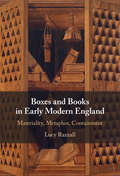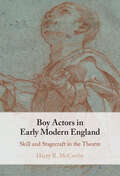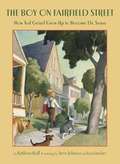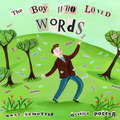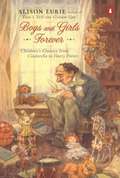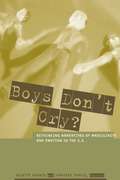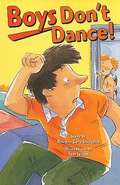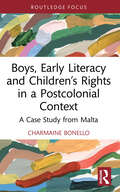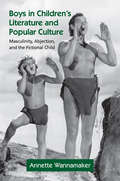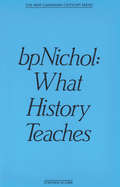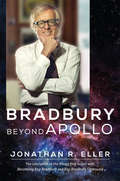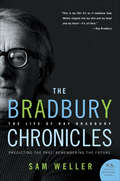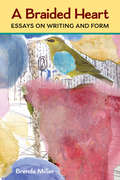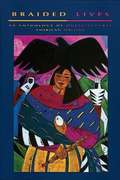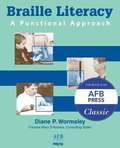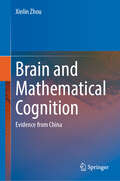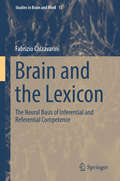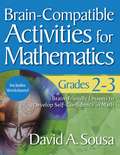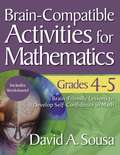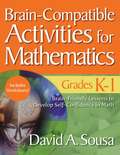- Table View
- List View
Boxes and Books in Early Modern England: Materiality, Metaphor, Containment
by Lucy RazzallIn early modern England, boxes furnished minds as readily as they furnished rooms, shaping ideas about the challenges of interpretation, and negotiations of the book itself as text and material object. Engaging with recent work on material culture and the history of the book, Lucy Razzall weaves together close readings of texts and objects, from wills, plays, sermons and religious polemic, to chests, book-bindings, reliquaries and coffins. She demonstrates how the material and imaginative possibilities of the box were dynamically connected in post-Reformation England, structuring modes of thought. These early modern responses to materiality offer ways in which the discipline of book history might reframe its analysis of the material text. In tracing the early modern significance of the box as matter and metaphor, this book reveals the origins of some of the enduring habits of thought with which we still respond to people, texts and things.
Boy Actors in Early Modern England: Skill and Stagecraft in the Theatre
by Harry R. McCarthyBoy Actors in Early Modern England: Skill and Stagecraft in the Theatre provides a new approach to the study of early modern boy actors, offering a historical re-appraisal of these performers' physical skills in order to reassess their wide-reaching contribution to early modern theatrical culture. Ranging across drama performed from the 1580s to the 1630s by all-boy and adult companies alike, the book argues that the exuberant physicality fostered in boy performers across the early modern repertory shaped not only their own performances, but how and why plays were written for them in the first place. Harry R. McCarthy's ground-breaking approach to boy performance draws on detailed analysis of a wide range of plays, thorough interrogation of the cultural contexts in which they were written and performed, and present-day practice-based research, offering a critical reimagining of this important and unique facet of early modern theatrical culture.
A Boy and a Jaguar
by Catia Chien Alan RabinowitzAlan loves animals, but the great cat house at the Bronx Zoo makes him sad. Why are they all alone in empty cages? Are they being punished? More than anything, he wants to be their champion--their voice--but he stutters uncontrollably.Except when he talks to animals...Then he is fluent. This real-life story with tender illustrations by Catia Chien explores truths not defined by the spoken word. <br><b>2015 Schneider Family Book Award Winner </b>
The Boy on Fairfield Street: How Ted Geisel Grew Up to Become Dr. Seuss
by Kathleen KrullIntroduces the life of renowned children's book author and illustrator Ted Geisel, popularly known as Dr. Seuss, focusing on his childhood and youth in Springfield, Massachusetts.
The Boy Who Loved Words
by Roni Schotter Giselle PotterIn this Parents' Choice Gold Award-winning book, Selig collects words, ones that stir his heart (Mama!) and ones that make him laugh (giggle). But what to do with so many luscious words? After helping a poet find the perfect words for his poem (lozenge, lemon, and licorice), he figures it out: His purpose is to spread the word to others. And so he begins to sprinkle, disburse, and broadcast them to people in need.
Boys and Girls Forever
by Alison LurieIt often seems that the most gifted authors of books for children are not like other writers: instead, in some essential way, they are children themselves. E. Nesbit devoted weeks to building a toy town out of blocks and kitchenware. James Barrie spent his holidays playing pirates and Indians with the four Davies boys. Laurent deBrunhoff, who has continued his father's BABAR series for many years, is still climbing trees at the age of 70. Beatrix Potter preferred the company of animals and pets to that of eligible young dancing partners at balls. In these fascinating studies, Alison Lurie's subjects range from what fairy tales tell us, to children's games and poetry by and for children, from book illustrators to enchanted forests and secret gardens in children's literature.
Boys and Girls in No Man's Land
by Susan FisherBoys and Girls in No Man's Land examines how the First World War entered the lives and imaginations of Canadian children. Drawing on educational materials, textbooks, adventure tales, plays, and Sunday-school papers, this study explores the role of children in the nation's war effort.Susan R. Fisher also considers how the representation of the war has changed in Canadian children's literature. During the war, the conflict was invariably presented as noble and thrilling, but recent Canadian children's books paint a very different picture. What once was regarded a morally uplifting struggle, rich in lessons of service and sacrifice, is now presented as pointless slaughter. This shift in tone and content reveals profound changes in Canadian attitudes not only towards the First World War but also towards patriotism, duty, and the shaping of the moral citizen.
Boys Don't Cry?: Rethinking Narratives of Masculinity and Emotion in the U.S.
by Milette Shamir Jennifer TravisWe take for granted the idea that white, middle-class, straight masculinity connotes total control of emotions, emotional inexpressivity, and emotional isolation. That men repress their feelings as they seek their fortunes in the competitive worlds of business and politics seems to be a given. This collection of essays by prominent literary and cultural critics rethinks such commonly held views by addressing the history and politics of emotion in prevailing narratives about masculinity. How did the story of the emotionally stifled U.S. male come into being? What are its political stakes? Will the "release" of straight, white, middle-class masculine emotion remake existing forms of power or reinforce them? This collection forcefully challenges our most entrenched ideas about male emotion. Through readings of works by Thoreau, Lowell, and W. E. B. Du Bois, and of twentieth century authors such as Hemingway and Kerouac, this book questions the persistence of the emotionally alienated male in narratives of white middle-class masculinity and addresses the political and social implications of male emotional release.
Boys Don't Dance! (Rigby PM Plus Blue (Levels 9-11), Fountas & Pinnell Select Collections Grade 3 Level Q)
by Tom Jellett Rowena LindquistLuke worries that his schoolmates might see him taking his sister to her dancing lesson. To his surprise, he finds that the class looks interesting and that dancing is fun.
Boys, Early Literacy and Children’s Rights in a Postcolonial Context: A Case Study from Malta (Routledge Research in Literacy Education)
by Charmaine BonelloThis book explores boys’ underachievement in literacy in early years education in Malta, using the dual lens of children’s rights and postcolonial theory. The author confronts issues in literacy attainment, early literacy learning and transitions to formal schooling with a case study from Malta. The book includes the voices of young boys who experience formal education from the age of five and adds a fresh perspective to existing literature in this area. Drawing on empirical research, the book traces the impact of foundational ideas of gender and early childhood, and makes practical recommendations to help young children experience socially just literacy education. This timely text will be highly relevant for researchers, educators and policymakers in the fields of literacy education, early childhood education, postcolonial education and children’s rights.
Boys in Children's Literature and Popular Culture: Masculinity, Abjection, and the Fictional Child (Children's Literature and Culture)
by Annette WannamakerBoys in Children’s Literature and Popular Culture proposes new theoretical frameworks for understanding the contradictory ways masculinity is represented in popular texts consumed by boys in the United States. The popular texts boys like are often ignored by educators and scholars, or are simply dismissed as garbage that boys should be discouraged from enjoying. However, examining and making visible the ways masculinity functions in these texts is vital to understanding the broad array of works that make up children’s culture and form dominant versions of masculinity. Such popular texts as Harry Potter, Captain Underpants, and Japanese manga and anime often perform rituals of subject formation in overtly grotesque ways that repulse adult readers and attract boys. They often use depictions of the abject – threats to bodily borders – to blur the distinctions between what is outside the body and what is inside, between what is "I" and what is "not I." Because of their reliance on depictions of the abject, those popular texts that most vigorously perform exaggerated versions of masculinity also create opportunities to make dominant masculinity visible as a social construct.
bpNichol
by Stephen ScobieScobie illuminates bpNichol's relationship to Dadaism, contemporary French literary theory and the writing of Gertrude Stein, and argues strongly for Nichol's importance as a writer of fiction.Other titles in The New Canadian Criticism Series:ABC of Reading the TRGTimothy Findley and the Aesthetics of FascismMichael Ondaatje: Word, Image, ImaginationMargaret Atwood: A Feminist PoeticsGeorge Bowering: Bright Circles of Colour
Bradbury Beyond Apollo
by Jonathan R. EllerCelebrated storyteller, cultural commentator, friend of astronauts, prophet of the Space Age—by the end of the 1960s, Ray Bradbury had attained a level of fame and success rarely achieved by authors, let alone authors of science fiction and fantasy. He had also embarked on a phase of his career that found him exploring new creative outlets while reinterpreting his classic tales for generations of new fans. Drawing on numerous interviews with Bradbury and privileged access to personal papers and private collections, Jonathan R. Eller examines the often-overlooked second half of Bradbury's working life. As Bradbury's dreams took him into a wider range of nonfiction writing and public lectures, the diminishing time that remained for creative pursuits went toward Hollywood productions like the award-winning series Ray Bradbury Theater. Bradbury developed the Spaceship Earth narration at Disney's EPCOT Center; appeared everywhere from public television to NASA events to comic conventions; published poetry; and mined past triumphs for stage productions that enjoyed mixed success. Distracted from storytelling as he became more famous, Bradbury nonetheless published innovative experiments in autobiography masked as detective novels, the well-received fantasy The Halloween Tree and the masterful time travel story "The Toynbee Convector." Yet his embrace of celebrity was often at odds with his passion for writing, and the resulting tension continuously pulled at his sense of self. The revelatory conclusion to the acclaimed three-part biography, Bradbury Beyond Apollo tells the story of an inexhaustible creative force seeking new frontiers.
The Bradbury Chronicles: The Life of Ray Bradbury
by Sam Weller“For Bradbury fans, THE BRADBURY CHRONICLES is essential. . . . [A]n engaging, often fascinating tale.” — New York Times Book Review“A fascinating look at a man’s work -- and the incredible evolution of an alien subgenre.” — Chicago Tribune “A highly readable story . . . informative, enjoyable, and inspiring.” — School Library Journal
A Braided Heart: Essays on Writing and Form (Writers On Writing)
by Brenda MillerA Braided Heart provides a friendly, personal, and smart guide to the writing life. It also offers clear and original instruction on craft elements at the forefront of today’s emerging forms in creative nonfiction: from the short-short, to the braided form, to the hermit crab essay. An acknowledged expert in these forms, Brenda Miller gives writers practical advice on how to sustain and invigorate their writing practice, while also encouraging readers to explore their own writing lives. “Brenda Miller writes so beautifully in these lyrical and ‘braided’ essays—personal meditations that take us deep into the miracle of writing itself. Her eye is always alert, her ear wonderfully tuned to the nuances of perception. The art of the essay is alive and well in her hands.” —Jay Parini, author of Borges and Me
Braided Lives: An Anthology of Multicultural American Writing
by Minnesota Humanities CommissionBraided Lives amplifies over forty different voices, bringing their distinctive sounds and stories to high school readers.
Braille Literacy: A Functional Approach
by Diane P. WormsleyWormsley (program director, Professional Preparation Program in Education of Children with Visual and Multiple Disabilities, Pennsylvania College of Optometry) describes an approach to braille reading and writing instruction based on students' individual interests, needs, and goals. She offers general guidelines for a functional approach to braille literacy, then offers case studies of how the program can be modified for at-risk learners. The approach works with children and adults learning braille for the first time. B&w photos of instructional materials are included. Annotation ©2004 Book News, Inc., Portland, OR (booknews.com)
Braille Literacy Curriculum
by Diane P. Wormsley" ... supports the goals of the National Agenda, emphasizes outcomes, and presents strategies for incorporating Braille into the total curriculum." Organized around outcomes in three areas: Emergent Literacy, Basic Literacy, Functional Literacy. Presented by grade cluster: Beginning (K-3), Intermediate (4-7), Advanced (8-12).
Brain and Mathematical Cognition: Evidence from China
by Xinlin ZhouThis book intends to present a series of insights coming from in-depth investigation of brain and mathematical cognition in Chinese population. Specifically, the book introduces research on the associations among number sense, visual form perception and mathematical fluency; symbolic and non-symbolic mental number line; and the role of spatial modeling and logical inference in mathematical problem solving. The book summarizes author's previous studies on the involvement of semantic network other than visuospatial network in mathematical cognition. The three-component mathematical model that comes out of more than 10 years of research on mathematical cognition is introduced. The book presents the effect of learning experience on arithmetic-related brain system. Chinese abacus that can be used to eradicate developmental dyscalculia in classroom is briefly discussed. Special attention in this book is paid to mathematical anxiety and mathematical learning disorders in Chinese schoolchildren. Finally, gender differences in mathematical cognition are also reviewed.
Brain and the Lexicon: The Neural Basis of Inferential and Referential Competence (Studies in Brain and Mind #15)
by Fabrizio CalzavariniThis monograph offers a novel, neurocognitive theory concerning words and language. It explores the distinction between inferential and referential semantic competence. The former accounts for the relationship of words among themselves, the latter for the relationship of words to the world. The author discusses this distinction at the level of the human brain on both theoretical and neuroscientific grounds. In addition, this investigation considers the relation between the inf/ref neurocognitive theory and other accounts of semantic cognition proposed in the field of neurosemantics, as well as some potential implications of the theory for clinical neuroscience and the philosophy of semantics. Overall, the book offers an important contribution to the debate about lexical semantic competence. It combines a strong philosophical and linguistic background with a comprehensive and critical analysis of neurosemantic literature. Topics discussed lie at the intersection of philosophical semantics, linguistics, neurolinguistics, cognitive science, artificial intelligence, cognitive neuroscience, and clinical psychology. Due to its interdisciplinary orientation, coverage is rich in introductory remarks and not overly technical, therefore it is accessible to non-experts as well.
Brain-Compatible Activities for Mathematics, Grades 2-3
by David A. SousaDemonstrating instructional principles discussed in David A. Sousa’s How the Brain Learns Mathematics, this resource provides brain-friendly, ready-to-use mathematics lessons for Grades 2-3. Teachers will find step-by-step guidance and all the necessary reproducible materials for mathematics instruction that involves group work, reflection, movement, and visualization. Through activities such as Jumping Jelly Beans, Math Hockey, and Treasure Hunt, young learners will enjoy developing skills connected with number patterns and place value, multi-digit addition and subtraction, multiplication and division, fractions, measurement, geometry, and more.Aligned with NCTM standards and focal points, the instructional strategies:Enhance motivation and content retentionAddress individual intelligencesPromote writing as an important learning toolUse concrete models to make concepts meaningfulConnect mathematical ideas to the real worldTeach creative problem solvingDeepen and revitalize instruction using Sousa’s proven brain-compatible approach for helping every student develop self-confidence in mathematics!
Brain-Compatible Activities for Mathematics, Grades 4-5
by David A. SousaBrain-Compatible Activities for Mathematics, Grades 4-5 provides brain-friendly, ready-to-use mathematics lessons for the classroom. Teachers will find step-by-step guidance and all the necessary reproducible materials for mathematics instruction that involves group work, reflection, movement, and visualization. Through activities such as Scuba Division, Party Planners, Sunken Treasure, and Parachute Drop, intermediate learners will enjoy developing skills connected with multiplication and division, fractions and decimals, geometry and measurement, algebra, data analysis, and more.Aligned with NCTM standards and focal points, the instructional strategies enhance motivation and content retention, while addressing individual intelligences. Also included is instruction to:Promote writing as an important learning toolUse concrete models to make concepts meaningfulConnect mathematical ideas to the real worldIncorporate graphic organizers to help students organize their thinkingDeepen and revitalize instruction using Sousa’s proven brain-compatible approach for helping every student develop self-confidence in mathematics!
Brain-Compatible Activities for Mathematics, Grades K-1
by David A. SousaUsing principals from Dr. David A. Sousa’s How the Brain Learns Mathematics, this user-friendly resource provides easy, ready-to-use mathematics lessons for Kindergarten and first grade classrooms. Teachers will find step-by-step guidance and all the necessary reproducible materials for mathematics instruction that involves partners, group work, and class movement. Through activities such as Number Jingle and Math Detective, young learners will enjoy developing skills connected with whole numbers, addition and subtraction, geometrical shapes, measurement, number patterns, and more.Aligned with NCTM standards and focal points, the resources in this book aim to enhance students’ motivation and content retention. Further, the principals in this book:Address individual intelligencesUse concrete models to make concepts meaningfulConnect mathematical ideas to the real worldIncorporate graphic organizers to help students organize their thinkingTeach creative problem solvingDeepen and revitalize instruction using Sousa’s proven brain-compatible approach for helping every child develop self-confidence in mathematics!
